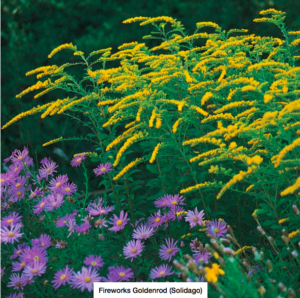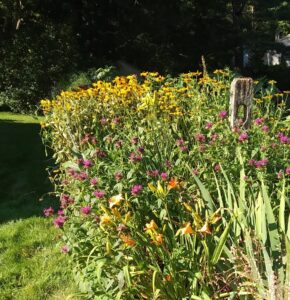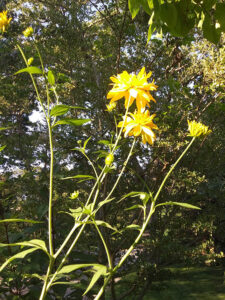Fall Gardening Tips
by Geri Williams
When planning your gardens try to have plants that bloom or have interest for each season for you and the pollinators to enjoy. It’s easy to have color in the spring with many different bulbs available, lots of spring ephemerals and glorious blooming shrubs and trees. Of course, in summer there are so many annuals and perennials that add varied colors and textures to our yards. For fall many of us rely on chrysanthemums to fill gaps and add color. But there are quite a few native plants that work as well.

Firecracker Goldenrod and Asters
We see the brilliant yellow of goldenrod along the highways and don’t think of them for our yards. However there are a number of goldenrod species that work well in gardens, and provide needed nectar and pollen for migrating Monarch butterflies, other pollinators and birds. They are not the cause of hay fever, it is ragweed pollen. showy goldenrod (Solidago speciosa) has stunning bright yellow plumes, stays in a neat clump and only grows 1-3 feet tall. Some taller varieties are better suited for the back of the border: Solidago odoro, commonly called sweet goldenrod, has anise scented leaves. It also is clump forming and grows 2-4 feet tall. Solidago rugosa, wrinkle leaf goldenrod, is a clump-forming native with 2–5-foot stems that have radiating or cascading light yellow flowers at the tips. One favorite named cultivar is ‘Fireworks’. You can control the size of these plants by pruning up to half the height in July and you will get bushier plants with more blooms in fall.

Brown-eyed Susans
Another long-time yellow favorite is black-eyed Susan. The perennial Rudbeckia hirta blooms from late summer into fall. It is very undemanding and flourishes in sandy soil with little moisture, and will even bloom in part shade, though it prefers sun. There is also a biennial brown-eyed Susan, Rudbeckia triloba, which can grow up to 4 feet tall and will continue to bloom until frost if you remove spent blooms. It is good to leave the dried seed heads on the plants through the winter for the birds.
The masses of lavender to purple small daisy like blooms of asters welcome fall and look amazing with the yellow of goldenrod and black-eyed Susans. Our native New England Aster, Symphyotrichum novae-angliae, can grow 3-6 feet tall, but if you cut it back early in the summer it will grow bushier with shorter, sturdier stems. There are other cultivars available from nurseries that naturally are shorter. Asters also do not require much moisture and tolerate poor soil.

Heliopsis
Last year I planted some Heliopsis helianthoides, sometimes called perennial sunflower or oxeye sunflower in a new garden by the road. It was a new native plant for me. This year I have loads of 1.5 inch yellow double flowers swaying on stems up to 7 feet tall. They started blooming at the end of July on 3-foot stems and are still blooming profusely.
I love dahlias, even though they are not native, because they bloom from midsummer right up to frost. I have some border dahlias that only grow 1.5 feet tall and need very little care, but reward with lots of 2-inch blossoms. I grow some along walkways and some in pots. Some with 4 inch pale pink flowers that I have had for years have multiplied and provide lots of cut flowers. These grow to 4 feet tall so they should be staked. Dahlias will not survive our winters in the earth, so I dig them up after frost, rinse the dirt off and let them dry in the plastic mesh trays you sometimes get from nurseries. After 3 or 4 weeks, I box them up in old cat litter tubs, separated by type in saved onion bags. I store them in my garage. My garage is minimally heated so they won’t freeze, but you could also store them in a cool basement.
Another favorite late fall flower of mine is Montauk or Nippon Daisy. This is a deciduous perennial that develops woody stems, which makes it seem more like a shrub. It has nearly 3inch white daisy flowers starting late September and usually continues to bloom until frost. The flowers can be cut and brought in to brighten your home. My chief concern is that it is a very vigorous grower (will quickly grow to 3 feet tall and wide) and I have to remember to cut the plants back severely in the spring and cut them back again at least once during the summer. But I have successfully grown many plants from the pieces I’ve cut off by simply sticking then in pots of soil and keeping them moist.
Mums come in many colors and are a wonderful sign of fall, but most often you have to purchase new ones each year. These other plants come back each year, you can often divide and spread or share them, and they offer other shapes, sizes and textures to your garden.
Try something new! Fall is a great time to plant, especially now that we finally have some rain. Happy gardening!

Great article!
Thank you for sharing! Gives me some great ideas for upcoming seasons!